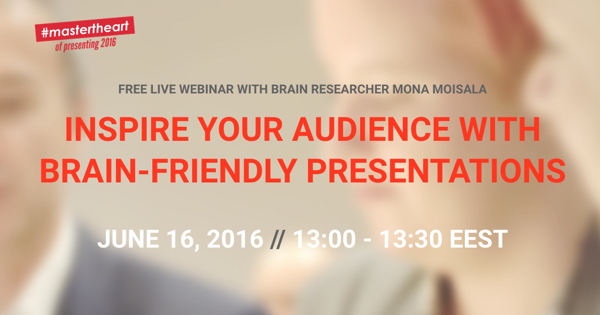How to create brain-friendly presentations? Master the Art of Presenting 2016 speaker, PhD candidate and brain researcher Mona Moisala shares her insights about how you can create more captivating presentations that will help you to get your message across to your audience.
Mona Moisala is a doctoral candidate majoring in psychology at the Faculty of Behavioural Sciences, University of Helsinki, Finland. Her PhD research involves studying the neural basis of attention and memory, and it tackles with questions such as what happens in the brain when we are trying multitask or ignore irrelevant distractors in the environment.
How to create brain-friendly presentations?
Bad presentations.
We’ve all experienced them! Trying to remain alert as the presenter whips out yet another slide full of complicated graphs and tons of text. Forcing ourselves to try and make sense of what the presenter is saying while deciphering the cryptic slides. Finally admitting defeat and turning to our smartphones to look at cat videos. This is a worst-case scenario, of course, and most presentations are thankfully not this painful for the audience!
It is quite common, however, that speakers forget to design their presentations so that the audience is able to follow and remember them later on. Luckily, there are simple ways to do this which involve understanding some of the basic principles of how the brains of your audience work.
Focus on 2-3 main points on your presentation
In many ways, the brain is still somewhat of a mystery even to brain researchers themselves. That being said, cognitive psychology and neuroscience have been able to unveil some of the fundamental properties of the brain which affect how brains process information. Two such properties are selective attention and working memory capacity.
The conscious mind is not able to perceive everything in the environment all at once, and we are in fact only observing fragments of it at any given time by selectively focusing our attention. Similarly, we can only hold a few pieces of information in our working memory at one time. It is therefore worthwhile to focus on 2-3 main points which you want to convey to your audience, and build your presentations around those main points.
You may feel tempted to cram everything you know about your topic of expertise into your presentation, but this will only overburden your audience!
Give your audience a break when giving a longer presentation
The mind also has a tendency to wonder, and it is difficult for us to stay vigilant and alert for long periods of time. Studies show that when doing something fairly monotonous, people are able to stay focused and alert state four roughly 20 minutes.
You might therefore want to give your audience a break if you are giving a longer presentation. Activate your audience with an assignment, or have a proper coffee break and let people have a stretch. They will return to your presentation with a fresh mind.
Don’t force your audience to multitask
Although we are able to perform many tasks simultaneously in everyday life (such as talking to a friend while driving a car), humans are quite poor at multitasking when the tasks being performed require active thinking. Many presenters force their audience to multitask by presenting slides full of text while talking at the same time.
As studies performed in our own laboratory show, this leads to the prefrontal cortex becoming substantially more active. This is because more cognitive control and effort is needed to understand both text and speech simultaneously.
Therefore, when giving a presentation, try to present as little text as possible when speaking, and show pictures instead. This way you are not setting the frontal lobes of your audience on fire!
Let them embrace emotions!
Finally, brain research has shown that when emotions are evoked during learning, this leads to stronger memory traces in the brain. This is because a different set of brain regions (such as the amygdala) are involved during memory formation when we feel a strong emotion than when we are in a neutral state. Advertisers exploit this by crafting ads which evoke emotions in the viewers in an effort to make them as memorable as possible.
Use this property of the brain to your advantage when giving presentations! Tell stories which people can empathize with, surprise the audience, make them laugh – embrace the full spectrum of emotion. Just make sure no one leaves your presentation crying!
By taking these few simple tips into consideration you are sure to give a much more brain-friendly presentation!
Learn more about brain-friendly presentations
Do you want to learn more about brain-friendly presentations? Join our FREE live webinar with Mona Moisala and learn how you can inspire your audience with brain-friendly presentations. The webinar is held on June 16th at 13:00. Watch the webinar record here!

